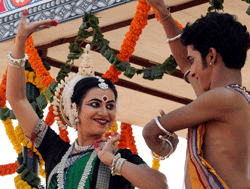
The glory of one of the greatest saints of the 19th century Swami Vivekananda, celebration of Indian cinema turning a century and replica of first cloned pashmina goat 'Noori' were among a range of themes that enthralled the audience at the Republic Day parade here today.
Tableaux from 14 states and five from various ministries and departments showcased India's varied cultural diversity. Vivekananda was the flavour of the season as a tableaux on the celebrated Saint of India was displayed, coinciding with his 150th birth anniversary celebrations.
Each state displayed little known aspects of its art and culture, while the tableaux of ministries showcased the functioning of their departments. The high point of tableaux was the Cinema Mayur Pankhi celebrating Indian cinema's 100 years,
The Cinema Mayur Pankhi, the Information and Broadcasting Ministry's float, paid tributes to several landmark movies, legendary musicians, singers and actors, including Guru Dutt, Dev Anand, Dilip Kumar, Amitabh Bachchan and Sridevi. Actor Irrfan Khan gave the voice over for the tableau.
Artistes depicting landmark roles in films like Gabbar Singh (Sholay), Mogambo (Mr India), Shehanshah (Shehanshah) and Bhuvan (Lagaan) were also be part of the tableau.
The first tableau to roll out was that of West Bengal which produced the "ethereal thinker-patriot-saint" Swami Vivekananda, whose 150th birth anniversary is falling this year.
Uttar Pradesh came up with 'Braj ki Holi' -- a cultural festival embracing all the social and regional diversities in itself. The tableau depicted a scene where the women of Barsana are trying to fend off the 'gops' of Nandgaon region of Brijbhumi.
The north-eastern state of Meghalaya, also known as the abode of clouds, showcased post-harvest festival dance Wangala, a thanks giving ceremony to their God 'Misi Saljong' (The Great Giver). The dance was played to beats of 100 drums.
It was a riot of colours that the Karnataka tableaux offered in terms of 'Kinna', its immortal colour craft primarily used to carve religious idols and toys. Its main attraction was Kamdhenu, the cow goddess of Indian mythology.
One of the interesting concept this year was from Jammu and Kashmir, which showcased a unique blend of tradition and technology with world's first cloned pashmina goat 'Noori' and the pashmina-making process. The clone has come as good news as the fine fibre-producing pashmina goat is only spotted at an altitude of 14,000 feet in Ladakh.
Jharkhand, which is participating in the parade after a gap of 5 years, depicted the Dokra art -- a specialised metal cast technique using lost wax casting.
The northern state of Himachal Pradesh showcased the craft, architecture and folk life of tribal district of Kinnaur while Kerala will come up a miniature landscape of the state with a houseboat.
Chhattisgarh tableau had Shiva, Buddha and Jain temples on board depicting the cultural prosperity and religious tolerance of its ancient city called Sirpur. Odisha tableau was based on the Chandan Yatra of Lord Jagannath.
The tableau from Rajasthan presented the Chitrashala of Bundi which is portrayed in the Fort of Bundi in the Hadoti region of Rajasthan. It also showcased the famous traditional art of Bundi School of miniature paintings.
Tripura this year brought to fore the famous Sangrai festival of its Mog Community where Mog women are shown in colourful dresses, waving umbrellas and fans of different shapes and sizes.
Bihar's tableau showed 'Kalash' made of beautifully dyed Sikki grass. In its tableau, the national capital Delhi pitched itself as the cultural hub of the country where performing arts and fine arts come together as red letter events.
Department of Central Public Works Department (CPWD) depicted the cycle of seasons (Ritus) i.e. Varsha Ritu, Grishma Ritu, and Sharad Ritu. The theme of Ministry of Railways was 'More coach per coach' which showed its new Air Conditioned Double Decker Train.
Ministry of Social Justice talks about Inclusion, Accessibility and Empowerment of persons with disabilities. Last on the list was the much talked about tableau of the Information and Broadcasting Ministry celebrating 100 years of Indian cinema.
In all, 28 entries were presented this year by various states and ministries out of this only 19 of them were selected to participate in the Republic Day Parade 2013 by a high-power committee comprising of eminent personalities.
In 2012, there were 23 tableaux which participated in the parade. However, this year the number has come down to 19. More than 400 artists, fabricators and designers living in the special artist village have worked day in and day out for months to build these tableaus.